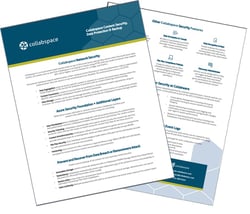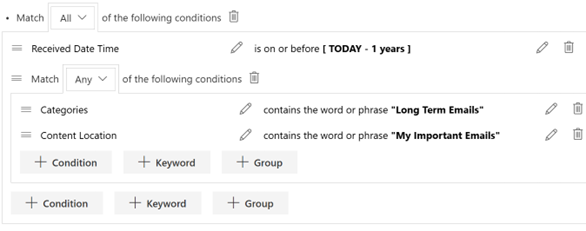As a go-to communication platform for conducting business, it’s common for email inboxes to become a buildup of attachments and dialogue regarding process, sales and other business-critical content.
Some may see the ever-growing inboxes and think that filing the emails within their email application, or perhaps removing emails from a server will solve their problem. But this is not a long term solution.
Enter email management.
What do we mean when we say email management? Today we'll cover...
- What email management is,
- Why email management is important,
- Common challenges that organizations can run into, and
- Best practices around email management that can be implemented to simplify this process.
Read on to learn more, and no, we’re not talking about sorting and cleaning out your inbox. Although if you’re interested in that, we have an article with tips for efficiently organizing your inbox to a level that would make Marie Kondo proud!
What is email management?
The definition of this term extends beyond just inbox sorting. Email management refers to organizations properly capturing, retaining and managing emails created and received by employees. As with other business records, classification schemes, retention periods and access controls can be applied to manage emails. Metadata from the emails should also be captured to allow the information to be managed and accessed by employees with proper permissions.
Why is email management important?
Just like any other business documentation, emails are considered official records and should be retained and managed according to organizational records management policies and practices. And with the mass quantities of email sent and received daily within an organization, email management is not only a records management issue, but a necessary business process.
High volumes of unmanaged emails in inboxes, sent folders and deleted items folders can pose the following risks:
- Individual employees managing their own emails) can result in business-critical data being lost or destroyed once the employee leaves/retires, resulting in loss of critical records and corporate memory
- Inefficient discovery and access to these records (whether for fulfilling a FOIA request, or conducting a general business inquiry)
- Difficulty for organizations to meet their legal preservation requirements (legal hold) in case of audits, litigation, etc.
Email management not only alleviates these risks, but also provides the following benefits:
-
Capturing communication history, including views to entire history of communications with any coworker, customer, prospect or business partner.
- Good for incident tracking, with all email messages relating to a specific incident or user automatically tracked and able to view as a single unit of correspondence.
-
Additional insights, as employees can use reporting systems to provide valuable insights into an organization's communications trends and efficiency. Read our white paper to learn more about how to achieve insights from unstructured data.
4 common challenges of email management
1. Volume
Email often has a higher magnitude of volume than any other type of content in most organizations. Studies show that the average employee sends and receives anywhere from 100‐200+ messages per day.
2. Various Email Types
Along with constant compounding volume of messages, emails often fall under a variety of categories. From important conversations with clients to calendar notifications and spam, an inbox is often filled with content that ranges from Highly Important business-critical information, to Less Important and Spam to dispose.
We've discussed an easy way to sort emails in our article about how to tidy your inbox for a first step, however, email management can also address this issue.
3. Multiple Formats & Versions
Beyond email 'types,' messages in inboxes also often includes attachments with various file formats and versions. Some threads may contain both business-critical and unimportant content in a single conversation, and CC and BCC can further complicate matters.4. High Cost of Storage
Not only do the variety and complexity of emails as records pose challenge and compliance risks, but the growing volume in storage often becomes a costly expenditure for organizations.
5 best practices for organizational email management
1. Automate as Much as Possible
Products that have advanced email integration can help with the challenges unique to email by allowing system administrators to automate more of the capture activities. Enabling a “file on send” feature lets organizations capture email as it is being sent, relieving the capture burden from the end user and helping meet any rigorous compliance requirements. Many systems also have automated capture upon receipt tools or integrated email archive utilities that can capture incoming email and automatically file it based on message metadata.
2. Email Management System to Help with Storage and Expense
The quantity and size of email is growing beyond the ability of many organizations to effectively administer it. Email integrations can help tremendously reduce storage volumes and duplication issues by allowing information workers to email links to documents already managed in a content system. This reduces the need to send copies – as email attachments typically are – repeatedly around the organization. Sending links to managed content also helps respect security on confidential documents, and ensures only current and approved versions of documents are viewed.
3. Manage Email by Role
One approach to automating email management is to manage it by role. This approach uses the email archiving approach to capturing everything, but it is only used for certain roles or users who are more likely to complete transactions or decisions using email. In that sense it reduces the distinction between records and non‐records, and in fact the bulletin notes that capture of non‐records or personal messages is likely.
This approach is much easier to understand and easier for users to comply with – because it’s a small subset of users, and they don’t have to do anything to comply. Instead, email is captured automatically.
4. Categorize Emails
Not all emails need to be kept. Only those emails that are official records must be retained: and this is a step that individual employees can step in to sort for themselves within their inboxes.
To effectively manage emails, staff should identify what is an official record and what is a transitory record. Official records include documented evidence business transactions, activities and decisions of an organization. They must be saved and stored securely so that they will be readily available to those who need them and are authorized to access them for future business, legal or archival purposes. Meanwhile, a transitory record has only immediate or short term value to the organization and are not required for future business, legal or archival purposes. These emails typically include personal and social messages, room booking and meeting reminders, ads, etc.
5. Retaining Emails in Electronic Format
Depending on the functionality of the electronic information management software, emails may be automatically transferred into a file or folder, or “dragged and dropped” into an appropriate file or folder. The retention and disposition of records may be set automatically in accordance with the organization’s records retention and disposition schedule, or the schedule may need to be applied manually to the records.
6. Train Staff
Email management should not fall on the shoulders of records managers: this is a process that requires ongoing training and support for staff. As part of their training, staff should be informed of the organization’s corporate email management policy and be able to identify what emails to keep as official records and what emails can be deleted; where official email records are to be stored; and that emails subject to an access to information request or litigation hold must not be disposed of. Most importantly, staff must be aware of how and where official record emails are to be captured and retained.
7. Have Exit Protocols In-Place
When an employee is retiring or otherwise leaving the organization, the employee should ensure that all official email records are transferred from their email mailboxes to the appropriate records management system before they leave. This step should be included in the organization’s checklist for exiting employees.
Conclusion
Email systems were designed to provide fast, efficient communications. Yet, email plays an important role in organizational performance and should be properly managed. The trouble is that capturing, managing and making the most of email is an increasing challenge as volume, variety and velocity of email continues to grow. Best practices such as selecting the proper email management system, automating, and having an exit strategy can help organizations account for email as a primary component of their information governance and content management efforts.
Want help putting these best practices into motion for your organization? Download our free Email Management information package below, or reach out to us with your questions! We create systems such as Collabspace, which automates retention, classification and email workflows for compliant and secure content management in the Cloud, plus increased productivity for your team! Find out more:







